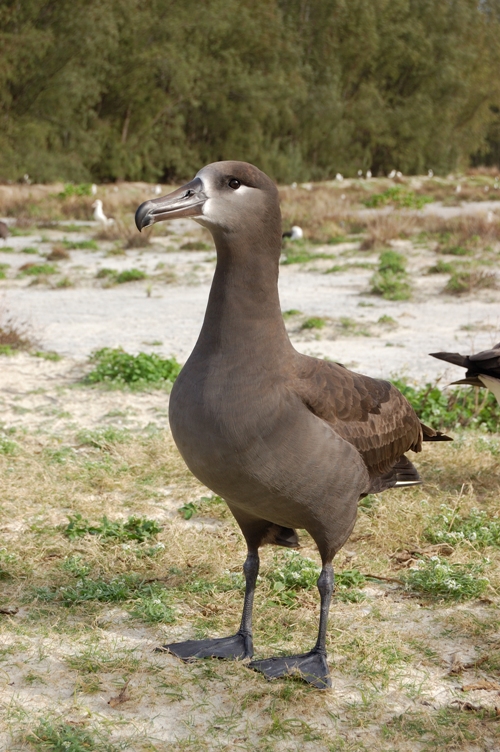|
| 질의: flying fish | 결과: 87번째/155 | |
Black-footed Albatross (Phoebastria nigripes) - Wiki
| 제목: | Black-footed Albatross (Phoebastria nigripes) - Wiki
| |

| 해상도: 500x752
파일크기: 329795 Bytes
촬영일: 2007:02:25 14:32:50
사진기: NIKON D40 (NIKON CORPORATION)
F number: f/5.5
Exposure: 3125/1000000 sec
Focal Length: 48/1
등록시간: 2007:12:14 11:42:36
|
Black-footed Albatross
From Wikipedia, the free encyclopedia
Order: Procellariiformes
Family: Diomedeidae
[Photo] Black-footed Albatross (Phoebastria nigripes). Taken by - James Lloyd. Place - Sand Island, Midway Atoll. Febuary 2007. Source - http://www.pbase.com/freespirit/image/80500756 Copyright (C) 2007 James Lloyd
Permission is granted to copy, distribute and/or modify this document under the terms of the GNU Free Documentation License, Version 1.2 or any later version published by the Free Software Foundation; with no Invariant Sections, no Front-Cover Texts, and no Back-Cover Texts. A copy of the license is included in the section entitled "GNU Free Documentation License". |
The Black-footed Albatross, Phoebastria nigripes, is a large seabird from the North Pacific. It is one of three albatross that range in the northern hemisphere, nesting on isolated tropical islands.
Description
The Black-footed Albatross is a small member of the family (while still large compared to most other seabirds) that has almost all black plumage. 10% of individuals have white feathers at the base of the tail, and all adults have white markings around the base of the beak and below the eye. Its beak and feet are also all dark. They average at about 81 cm (32 in) in length, weigh about 3.3 kg (7.4 lbs) and have a wingspan of 2.1 m (6.9 ft).
Behavior and Range
Range
The Black-footed Albatross, along with the Laysan Albatross and the rare Short-tailed Albatross, are the three species of albatross that range in the northern hemisphere, as opposed to the rest of the family which range from the Equator south. They nest colonially on isolated islands of the Northwestern Hawaiian Islands (such as Laysan and Midway), and the Japanese islands of Toroshima Island, Bonin, and Senkaku. Their range at sea varies during the seasons (straying farther from the breeding islands when the chicks are older or they don't have chicks) but they make use of great areas of the North Pacific, feeding from Alaska to California and Japan. They overlap greatly in breeding and feeding range with the other two species of northern albatross, although the other two will range further north into the Bering Sea than the Black-footed will.
Breeding
The Black-footed Albatross, like the rest of its family, forms long term pair-bonds that last for life. After fledging the birds return to the colony after three years, and spend two years building nests, dancing and being with prospective mates, a behaviour that probably evolved to ensure maximum trust between the birds (raising an albatross chick is a massive energetic investment, and a long courting period establishes for both birds that the other is committed).
Nests are simple depressions scraped in the sand, into which one egg is laid. The egg is incubated for just over two months (65 days). Both birds incubate the egg, the male incubating more as the female leaves soon after hatching to recoup reserves used for egg-laying. The average time spent on incubating shifts is 18 days. However, mates can wait up to 38 days to be relieved, and if something happens to the mate the other has been recorded incubating for 49 days without food or water.
The chick is brooded for 20 days by its parents, after which both parents leave the nest and return to feed the chick. The chick is fed regurgitated food by sticking its bill inside that of its parent. Fledging occurs after 140 days.
Feeding
The Black-footed Albatross feeds in pelagic waters, taking fish, mostly the eggs of flying fish, squid and to a lesser extent crustaceans. It has been described as a 'floating pig' by one author for its habit of taking kitchen scraps from ships. It will also consume floating debris, including plastics.
Conservation
The Black-footed Albatross is considered endangered, because it is taken incidentally by long-line fishing. An estimated 4,000 are taken every year, based on the number taken in 1990; other estimates put the number at 8,000. It is also vulnerable to oil and ingestion of floating plastics, which reduces the space in the stomach available for food to be brought to the chick. All of its nesting sites in the U.S. are protected.
http://en.wikipedia.org/wiki/Black-footed_Albatross
| The text in this page is based on the copyrighted Wikipedia article shown in above URL. It is used under the GNU Free Documentation License. You may redistribute it, verbatim or modified, providing that you comply with the terms of the GFDL. |
|
^o^
동물그림창고 똑똑전화 누리집
^o^
|
|

